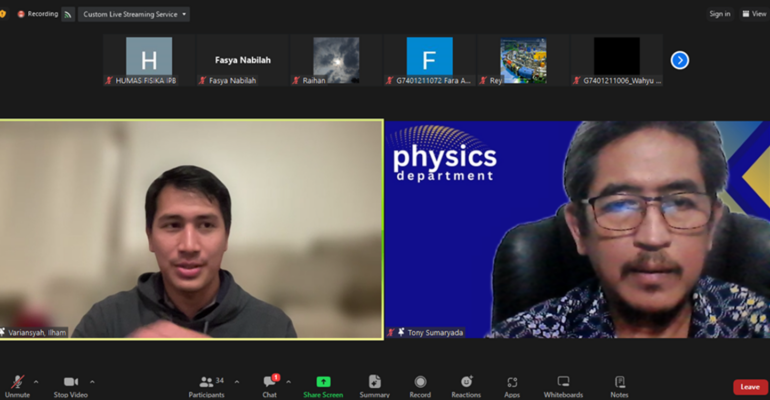Present at IPB, Oregon State University Expert Outlines the Urgency of Nuclear Energy Development to Reduce the Impact of Climate Change

What comes to mind when you hear the word nuclear? Most likely the atomic bomb, Chernobyl, Fukushima, nuclear leak, radiation and all the other horrors. Is it true that nuclear energy is so horrific in its risks compared to its benefits?
To reveal this, recently the Department of Physics, Faculty of Mathematics and Natural Sciences (FMIPA) IPB University held the 60th IPB Physics Talk series by inviting Dr Ilham Variansyah, an Assistant Professor of Nuclear Science Engineering at Oregon State University, USA.
Prof Tony Sumaryada, Chairman of the Physics Department of IPB University gave his greatest appreciation to Dr Ilham Variansyah who had shared his knowledge and insights related to nuclear energy and its relation to global climate change.
“It is hoped that real research collaboration between the Physics Department of IPB University and leading global partners such as Oregon State University can continue to be fostered and developed for the progress of the nation,” he said.
At the beginning of the presentation, Dr Ilham explained the development of world energy consumption and its impact on global temperature rise. He explained the comparison between fossil fuel and nuclear reactions.
“For one carbon combustion reaction as we utilise fossil fuels, it produces 4 electron volts (eV) of energy along with the release of one CO2 gas. Meanwhile, one nuclear fission reaction produces 200 million eV of energy, and without the release of CO2 gas,” he explained.
He further explained, the energy density of nuclear reactions which is 50 million times greater than fossil fuels without the impact of the greenhouse effect, should be a serious consideration for the use of this energy in the future to mitigate global climate change.
“A large energy density also means a smaller ecological footprint. The greater the energy produced, the smaller the waste from the need for other supporting raw materials. Even the nuclear waste produced by all nuclear reactors in the USA can be compressed into a room the size of a football field,” said Dr Ilham.
He elaborated, nuclear waste itself is actually not pure waste, but is the residue of nuclear fuel. With further treatment, the nuclear waste can be reused as reactor fuel again.
In addition, at the United Nations Climate Change Conference (COP 28) last December 2023 in Dubai, United Arab Emirates (UAE), a determination was made to triple the world’s nuclear energy capacity by 2050.
This drastic paradigm shift from world institutions towards the use of nuclear energy must be responded to by all countries, including Indonesia. This is so that each country can be better prepared in the development of nuclear power reactors in the future.
Security issues against nuclear reactors have been an obstacle in the development and expansion of nuclear power reactor construction in various parts of the world. However, along with technological developments, especially with the emergence of the latest fourth-generation reactors that have passive safety systems, the nuclear reaction process will stop automatically without the need for external control from the operator. An example of this type of reactor is the High Temperature Gas-cooled Reactor (HTGR) reactor with small pellet-shaped fuel (Pebble bed reactor).
Another issue is the opportunity for misuse of power reactors for nuclear weapons development. Dr Ilham explained that nuclear power reactor technology is completely different from technology for nuclear weapons development, so the concern is unfounded. The world nuclear energy agency (IAEA) is also known to have very strict controls on all its member countries regarding the possession and use of radioactive materials. (*/Rz) (IAAS/RUM)


